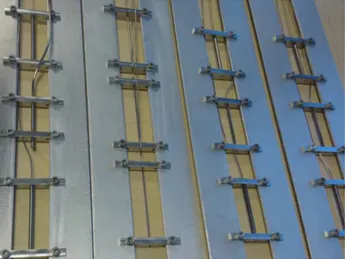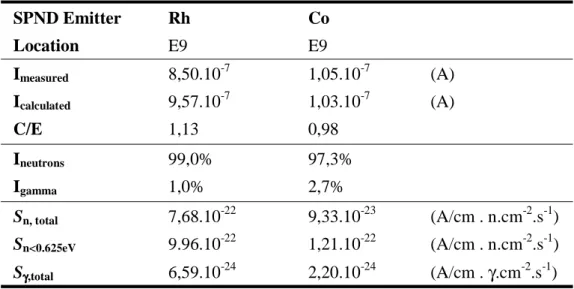HAL Id: cea-02509733
https://hal-cea.archives-ouvertes.fr/cea-02509733
Submitted on 17 Mar 2020HAL is a multi-disciplinary open access archive for the deposit and dissemination of sci-entific research documents, whether they are pub-lished or not. The documents may come from teaching and research institutions in France or abroad, or from public or private research centers.
L’archive ouverte pluridisciplinaire HAL, est destinée au dépôt et à la diffusion de documents scientifiques de niveau recherche, publiés ou non, émanant des établissements d’enseignement et de recherche français ou étrangers, des laboratoires publics ou privés.
Experimental validation of a Monte Carlo based toolbox
for self-powered neutron and gamma detector simulation
in the OSIRIS MTR
L. Barbot, V. Radulovic, C. Destouches, J.-F. Villard, V. Dewynter-Marty, F.
Malouch, F. Lopez
To cite this version:
L. Barbot, V. Radulovic, C. Destouches, J.-F. Villard, V. Dewynter-Marty, et al.. Experimental validation of a Monte Carlo based toolbox for self-powered neutron and gamma detector simulation in the OSIRIS MTR. PHYSOR 2016 - Unifying Theory and Experiments in the 21st Century, May 2016, Sun Valley, United States. �cea-02509733�
Sun Valley Resort, Sun Valley, Idaho, USA, May 1 – 5, 2016, on CD-ROM (2016)
EXPERIMENTAL VALIDATION OF A MONTE CARLO BASED TOOLBOX
FOR SELF-POWERED NEUTRON AND GAMMA DETECTOR SIMULATION
IN THE OSIRIS MTR
Loic Barbot, Vladimir Radulović, Christophe Destouches, Jean-François Villard
CEA, DEN, DER, Instrumentation Sensors and Dosimetry Laboratory Cadarache, F-13108 Saint-Paul-Lez-Durance, France
loic.barbot@cea.fr
Veronique Dewynter-Marty
CEA, DEN, DANS, DRSN, SIREN, LESCI Saclay, F-91191 Gif sur Yvette, France
veronique.dewynter-marty@cea.fr Fadhel Malouch, Franck Lopez
CEA, DEN, DANS, DM2S, SERMA Saclay, F-91191 Gif sur Yvette, France
fadhel.malouch@cea.fr ABSTRACT
A numerical toolbox based on Monte Carlo calculations for self-powered neutron and gam-ma detector design, simulation and operation has been developed in order to save operators
numerous and fastidious calibration tests. The experimental validation of this numer-ical toolbox, called ‘MATiSSe’, in the OSIRIS Material Testing Reactor is fully de-tailed in the paper. C/E comparisons presuppose promising future application for the numerical toolbox.
Key Words: Neutron flux, Gamma flux, Self-powered detectors, Simulation, Monte Car-lo codes.
1. INTRODUCTION
The future Jules Horowitz Material Testing Reactor (JHR – Cadarache, France) will host a large variety of irradiation experiments, which will require several diverse neutron and gamma detectors. Self-Powered Neutron (and Gamma) Detectors, SPND (and SPGD), are already identified as major contributors to neutron (and gamma) level qualification in JHR irradiation experiments, due to their robust construction, simple use and relatively low cost. Nevertheless SPND response calibrations need to be adapted to diverse irradiation conditions, requiring numerous and fastidious SPND cali-bration tests from the operators. In this perspective, the Instrumentation Sensors and Dosimetry Laboratory (LDCI) of CEA Cadarache (France) developed, since 2010, a numerical toolbox based on Monte Carlo calculations for self-powered neutron detector design, simulation and operation. This CEA SPND simulation toolbox was named ‘MATiSSe’ for ‘Monte cArlo Tool for SPND
L. Barbot et al.
2 / 5 PHYSOR 2016 – Unifying Theory and Experiments in the 21st Century Sun Valley, Idaho, USA, May 1 – 5, 2016 The main purpose of this paper is to present the full description of the ‘MATiSSe’ toolbox features and its experimental validation performed in late 2014, testing several different self-powered detec-tors at various locations in the OSIRIS MTR reflector (CEA Saclay, France). The SPND theory, the associated Monte Carlo model and their implementation in the MATiSSe toolbox are detailed in the first part of the paper. The experimental set-up and dedicated coupled neutron-gamma field calcula-tions are thoroughly described in the second part. The validation of the ‘MATiSSe’ toolbox is dis-cussed in the third part with calculation to experiment comparison of self-powered detectors signals.
2. SELF-POWERED DETECTOR SIMULATION
The CEA MATiSSe toolbox is based on a multistep Monte Carlo calculation model where SPNDs and their immediate environment are finely modeled (geometry and material definition). The SPND model origins from SCK•CEN previous works [1] and it has been constantly upgraded at CEA since 2010. The SPND response is predicted through thorough calculations of neutron and gamma partial sensitivities of the sensor, using close neutron and gamma fields (levels and spectra) accurately es-tablished beforehand.
Figure 1. Block diagram of the MATiSSe toolbox for self-powered detector simulation.
The SPND model relies on two fundamental points: the exhaustive study of possible free electron creation sources within SPND materials and transport calculations of these electrons in the different SPND components and their corresponding charge deposition. The MATiSSe toolbox runs the mul-tistep SPND model in adequate order, starting from a user SPND definition. The Monte Carlo (MCNP6.1 [2]) and analytical calculations are coded separately in macro bodies in C++ language. The user defines the SPND geometry and launches calculations from a GUI developed using the Qt Creator 3.5.0 program. Final MATiSSe output is an absolute direct electrical current in Amps.
The MATiSSe toolbox complete experimental validation was performed recently in the French CEA Saclay OSIRIS reactor. Various neutron and gamma self-powered detectors have been tested in the reflector of the OSIRIS reactor during a dedicated experimental campaign. Measured and calculated SPD signals are compared.
3. EXPERIMENTAL VALIDATION
Aiming at the MATiSSe toolbox validation, CEA LDCI performed dedicated SPND tests in the OSIRIS Material Testing Reactor (CEA Saclay – France – 70 MW) in the frame of a CEA internal experimental project called VASCO (French acronym for SPND simulation validation in OSIRIS), in collaboration with CEA SIREN (Reactor Irradiations and Nuclear Studies section) and SERMA (Reactor and Applied Mathematics Studies section) units.
3.1 Experimental Set-up
Different types of self-powered detectors (11 in total), including ones with rhodium, cobalt and bismuth emitters, have been tested in two irradiation locations in the OSIRIS reflector (called E9 and E10), presenting different neutron to gamma flux ratios. VASCO SPNDs were mounted in threes on aluminium plates which were placed diagonally in the irradiation locations (square section aluminium water boxes). Aluminium plates ensured repeatable positioning of detectors in the centre of irradiation locations (aluminium water boxes).
In addition to self-powered detector irradiation tests, neutron flux levels (thermal and fast) in the experimental locations have been experimentally determined using activation detectors. Gamma flux levels were also evaluated using a CEA recently developed process for miniature ionization chamber (MIC) signal analysis [3].
L. Barbot et al.
4 / 5 PHYSOR 2016 – Unifying Theory and Experiments in the 21st Century Sun Valley, Idaho, USA, May 1 – 5, 2016
3.2 Specific Monte Carlo Calculations
Neutron and gamma spectra and absolute flux levels are of essential importance as entry data for the MATiSSe toolbox.
OSIRIS calculation support unit (SERMA) performed specific neutron and gamma three-dimensional calculations to evaluate neutron and gamma flux levels and spectra in irradiation locations. These calculations are based on the TRIPOLI-4® three-dimensional continuous-energy Monte Carlo particle transport code [4], developed at CEA Saclay and extensively validated against reactor dosimetry benchmarks. In these calculations, simultaneous contribution of neutrons and gamma is considered using neutron-photon coupled transport calculations. Contributions of prompt and delayed photons have been taken into account for the gamma flux calculation. Specific deple-tion codes are used upstream to provide the decay-gamma sources required by TRIPOLI-4® calcu-lations. Unperturbed and perturbed calculations were performed to check the impact of the detectors themselves on their environment [5].
4. RESULTS
Although MATiSSe toolbox complete experimental validation is still in progress, preliminary re-sults with unperturbed neutron and gamma fluxes show very satisfactory calculation to experiment ratios (See Table 1) and calculated partial sensitivities of the detectors are comparable to literature other works [6].
Final results of all tested detectors with final reactor condition calculations will be performed until of the end of 2015 and will be included in the full paper for the submission deadline in January 2016.
Table 1. Preliminary results of the MATiSSe toolbox SPND simulation compared to actual
meas-urements in the OSIRIS reactor.
SPND Emitter Rh Co Location E9 E9 Imeasured 8,50.10-7 1,05.10-7 (A) Icalculated 9,57.10-7 1,03.10-7 (A) C/E 1,13 0,98 Ineutrons 99,0% 97,3% Igamma 1,0% 2,7% Sn, total 7,68.10-22 9,33.10-23 (A/cm . n.cm-2.s-1) Sn<0.625eV 9.96.10-22 1,21.10-22 (A/cm . n.cm-2.s-1) Sγγγγ,total 6,59.10-24 2,20.10-24 (A/cm . γ.cm-2.s-1)
5. CONCLUSION
Fully characterized experimental locations in a nuclear reactor with dedicated Monte Carlo calcula-tions of neutron and gamma flux spectra and levels, activation dosimetry and ionization chamber measurements are almost unique. They can be considered as reference locations for calculation to experiment comparisons. The VASCO experiment, performed in the OSIRIS reactor, was a great opportunity to experimentally validate the CEA MATiSSe toolbox developed for self-powered neu-tron and gamma detectors.
SPND C/E ratios already available are very satisfactory in the frame of the LDCI MATiSSe toolbox validation. The complete analysis of the VASCO experiment will be presented in the full paper. It should demonstrate that the LDCI MATiSSe toolbox is ready for nuclear instrumentation definition of irradiation experiments in the future Jules Horowitz Reactor (JHR). Furthermore, the LDCI MA-TiSSe toolbox applications are wider than research reactor community; MAMA-TiSSe toolbox was used to complete LDCI expertise for the French nuclear industry and the French national research agen-cy.
ACKNOWLEDGMENT
This work was performed with funding from the Nuclear Instrumentation Project of the CEA Nu-clear Energy Division.
REFERENCES
[1] L. Vermeeren, R. Van Nieuwenhove‚ ‘Theoretical study of radiation induced electromotive force effects on mineral insulated cables’, American Institute of Physics, Review of Scientific In-struments volume 74 - number 11, 2003.
[2] X-5 Monte Carlo Team, MCNP6 User’s Manual, Version 1.0, May 2013, LA-CP-13-00634.
[3] D. Fourmentel et al., ‘Delayed gamma measurements in different nuclear research reactors bringing out the importance of the delayed contribution in gamma flux calculations’, 4th Interna-tional Conference ANIMMA 2015, 20-24 April 2015, Lisbon, Portugal.
[4] TRIPOLI-4 Monte Carlo Transport Code, http://www.nea.fr/abs/html/nea-1716.html (2013).
[5] F. Malouch et al., ‘Calculation of neutron and gamma fluxes in support to the interpretation of measuring devices irradiated in the core periphery of the OSIRIS Material Testing Reactor’, 4th International Conference ANIMMA 2015, 20-24 April 2015, Lisbon, Portugal.
[6] L. Barbot et al., ‘Calculation to experiment comparison of SPND signals in various nuclear reactor environments’, 4th International Conference ANIMMA 2015, 20-24 April 2015, Lisbon, Portugal.


